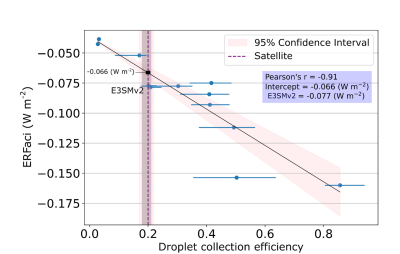Satellite Observations Constrain Model Aerosol Forcing Uncertainty Due to Raindrop Formation
The impact of aerosol-cloud interactions (ACIs) on the Earth’s radiative budget is among the most uncertain aspects of climate prediction. Earth system models estimate the contribution of ACIs to Earth’s energy budget in different climate-forcing scenarios. Efforts to constrain model estimates with available observations have proven challenging. Traditional state-based approaches evaluate models by constraining a number of atmospheric properties against observations, but multiple choices of model representations of ACIs can yield equivalent atmospheric outcomes. Researchers seeking accuracy have, in recent studies, called for constraints on specific cloud processes.
In this study, researchers demonstrate how joint satellite observations from the MODerate Resolution Imaging Spectroradiometer (MODIS) and CloudSat radar can be used to constrain the ACI radiative forcing that is linked to droplet collection in marine liquid clouds. Using the Department of Energy’s Energy Exascale Earth System Model version 2 (E3SMv2) and an updated analysis of combined MODIS–CloudSat observations that provide a proxy for droplet collection efficiency, researchers show that the effective radiative forcing of ACI (ERFaci) due to raindrop formation can be constrained using the strong relationship between them. Researchers find that E3SMv2’s value agrees with the constrained value, suggesting the model’s representation of raindrop formation contributes negligibly to overall ERFaci uncertainty in marine liquid clouds.
The study demonstrates a highly desirable process-based constraint on ERFaci in low-level liquid clouds. While researchers show how contoured frequency by optical depth diagram (CFODD) analysis applies to raindrop formation, future studies can apply CFODD analysis to any model process that affects droplet collection efficiency, including raindrop growth, droplet breakup, and evaporation.
Results show that the areal fraction of the low-level liquid clouds featured in E3SMv2 agrees with MODIS-CloudSat within 3% (global ocean mean), but there is a strong bias toward small cloud top droplet sizes. Considering that the constrained value of ERFaci strengthens with increasing cloud top droplet effective radius and that E3SMv2’s total ERFaci (−1.50 W m-2) is relatively strong compared to the IPCC AR6 “very likely” range (−1.0 ± 0.7 W m-2), the overrepresentation of low-level clouds with small cloud top droplet size represents a compensating bias, without which the total ERFaci would be even stronger compared to IPCC AR6.
Process-oriented constraints on ERFaci, such as the updated CFODD analysis presented in this study, show how much a specific cloud process contributes to overall ERFaci uncertainty, illuminating where to focus model development efforts. Researchers constrain the component of ERFaci associated with raindrop formation in low-level liquid clouds, where ACI makes a substantial contribution to the global radiative forcing of the climate. Researchers find that E3SMv2’s ERFaci agrees with the MODIS-CloudSat constrained value within uncertainty, indicating that the model’s raindrop formation parameterization contributes negligibly to overall ERFaci uncertainty. The results also illuminate a compensating bias linked to an overrepresentation of low-level liquid clouds with small cloud-top droplet sizes, without which E3SMv2’s relatively strong ERFaci (−1.50 W m-2) would be even stronger. The updated CFODD analysis has been implemented into open-source software to support E3SM’s continued development with observations-based evaluation tools and ERFaci constraints.

